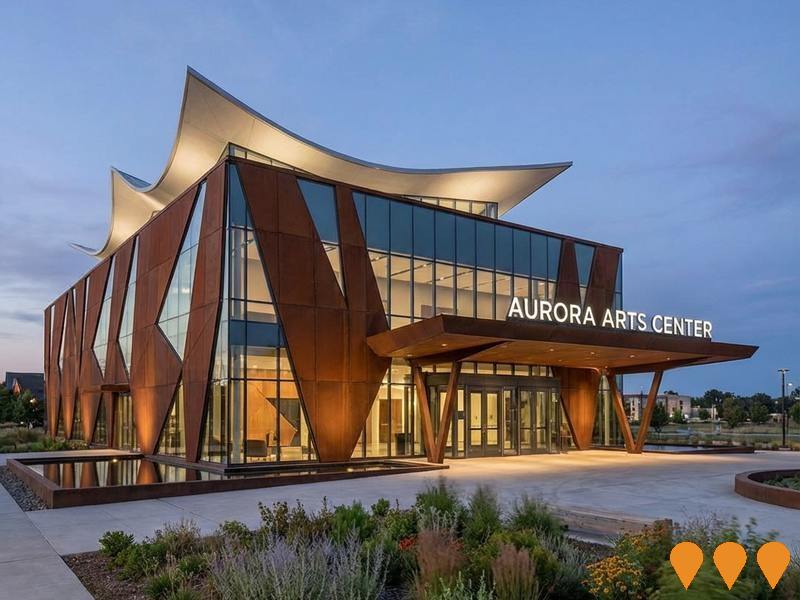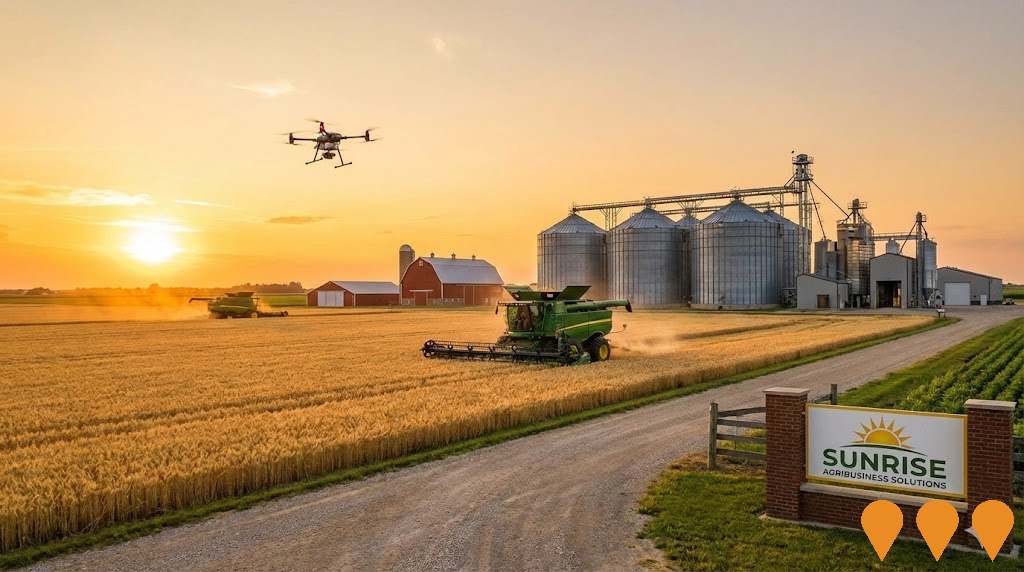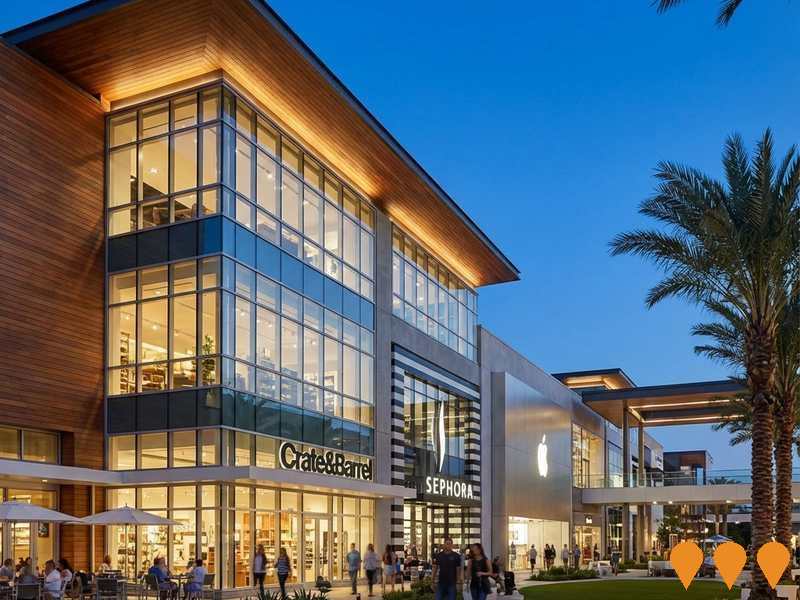Chart Color Schemes
est. as @ -- *
ABS ERP | -- people | --
2021 Census | -- people
Sales Activity
Curious about local property values? Filter the chart to assess the volume and appreciation (including resales) trends and regional comparisons, or scroll to the map below view this information at an individual property level.
Find a Recent Sale
Sales Detail
Population
Parkes Surrounds has shown very soft population growth performance across periods assessed by AreaSearch
Parkes Surrounds' population is approximately 3,106 as of Aug 2025. This figure indicates a decrease from the 2021 Census count of 3,262 people, marking a reduction of 156 individuals (4.8%). The decline is inferred from ABS's estimated resident population of 3,094 in June 2024 and two validated new addresses since the Census date. The population density stands at 0.60 persons per square kilometer. Natural growth contributed around 52.8% to overall population gains recently.
AreaSearch uses projections from ABS/Geoscience Australia for each SA2 area, released in 2024 with a base year of 2022. For areas not covered by this data, AreaSearch employs NSW State Government's SA2 level projections, released in 2022 with a base year of 2021. Growth rates by age group are applied to all areas for years 2032 to 2041. By 2041, Parkes Surrounds is projected to increase by around 265 persons, reflecting an 8.1% rise over the seventeen-year period, in line with median growth trends outside capital cities.
Frequently Asked Questions - Population
Development
The level of residential development activity in Parkes Surrounds is very low in comparison to the average area assessed nationally by AreaSearch
Parkes Surrounds has had minimal residential development activity, with an average of 2 dwelling approvals per year over the past five years (11 approvals in total). This low level of development is typical of rural areas where housing needs are modest and construction activity is limited by local demand and infrastructure capacity. It should be noted that with such low approval numbers, yearly growth figures can vary significantly based on individual projects.
The area shows considerably less construction activity than the Rest of NSW and its development levels are below national averages. All new constructions have been detached dwellings, reflecting rural living preferences for space and privacy. As of now, there are an estimated 2326 people in the area per dwelling approval, indicating a quiet, low activity development environment. By 2041, Parkes Surrounds is projected to grow by 251 residents.
At current development rates, housing supply may struggle to keep pace with population growth, potentially increasing buyer competition and supporting price increases.
Frequently Asked Questions - Development
Infrastructure
Parkes Surrounds has emerging levels of nearby infrastructure activity, ranking in the 26thth percentile nationally
Changes to local infrastructure significantly impact an area's performance. AreaSearch identified 26 projects likely influencing the region. Notable ones are Ridgey Creek Battery Energy Storage System, Stevens Group BP Highway Service Centre - Northern Gateway, Parkes Hospital (Lachlan Health Service), and Parkes National Logistics Hub Infrastructure Extension. The following list details those most relevant.
Professional plan users can use the search below to filter and access additional projects.
INFRASTRUCTURE SEARCH
 Denotes AI-based impression for illustrative purposes only, not to be taken as definitive under any circumstances. Please follow links and conduct other investigations from the project's source for actual imagery. Developers and project owners wishing us to use original imagery please Contact Us and we will do so.
Denotes AI-based impression for illustrative purposes only, not to be taken as definitive under any circumstances. Please follow links and conduct other investigations from the project's source for actual imagery. Developers and project owners wishing us to use original imagery please Contact Us and we will do so.
Frequently Asked Questions - Infrastructure
Parkes Hospital (Lachlan Health Service)
NSW Government delivered a $72.8 million modern hospital for Parkes at a new site, opened on 24 November 2015. The facility provides a 24-hour emergency department, medical imaging, ambulatory care, inpatient units, chemotherapy and surgical services, with maternity and birthing suites. It serves Parkes and surrounding communities within the Western NSW Local Health District.
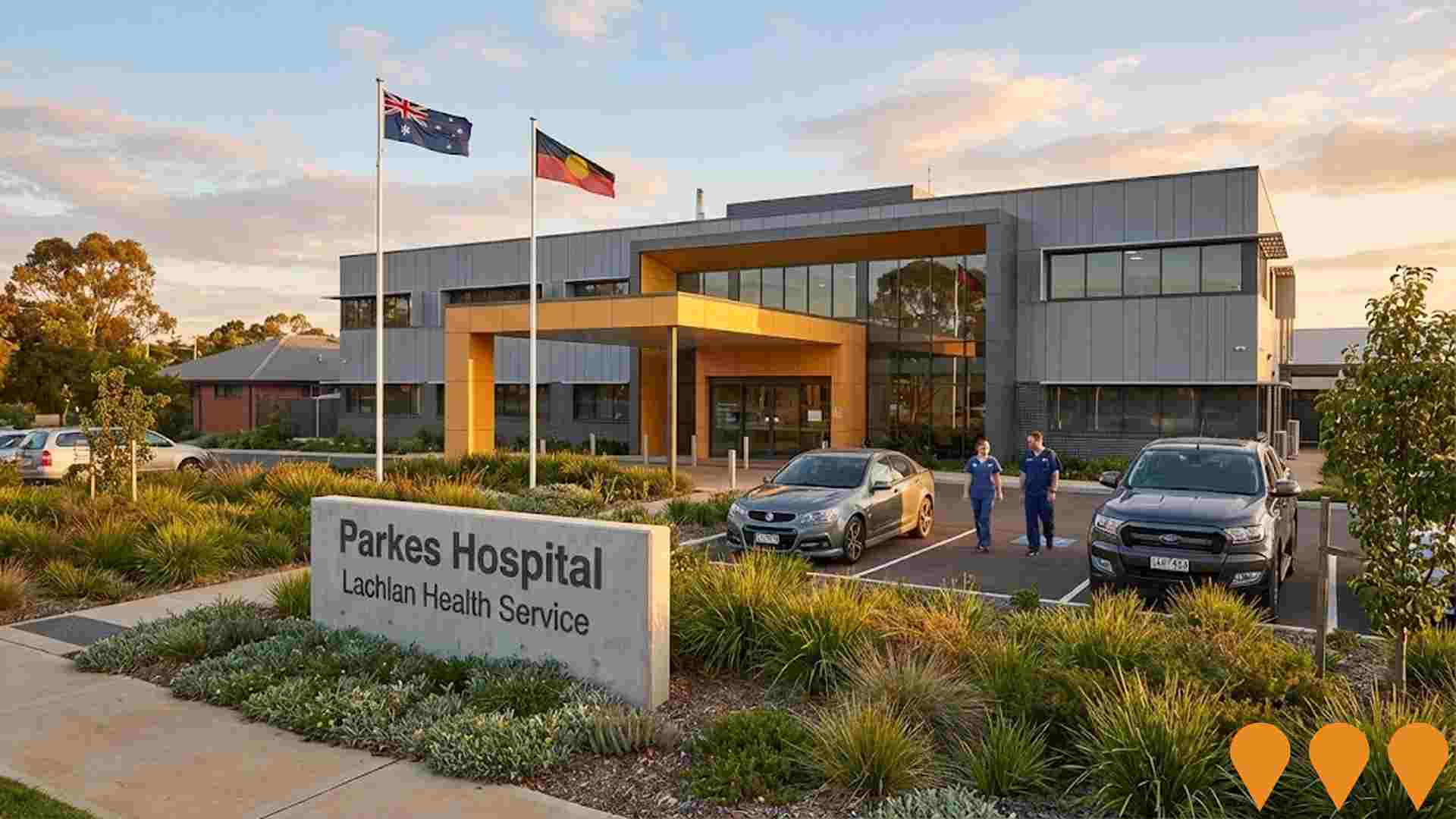
Parkes Special Activation Precinct
A 4,800 hectare eco-industrial precinct at the junction of Australia's two rail spines (Inland Rail and Trans-Australian Railway), aiming to become the nation's largest inland freight and logistics hub. The project is currently in the delivery phase, led by the Regional Growth NSW Development Corporation. Enabling works are underway, including a $126 million contract for the upgrade of 7.3km of Brolgan Road, construction of two rail overpass bridges, and new supporting utilities (water, sewer, electricity, gas, telecommunications). The precinct is designed as Australia's first UNIDO Eco-Industrial Park, focusing on sustainability and circular economy principles. Key anchor tenants include Brightmark, Pet Care Kitchen, and Stevens Group (developing the BP Highway Service Centre). The project is expected to create up to 3,000 jobs across logistics, manufacturing, recycling, and data centres.
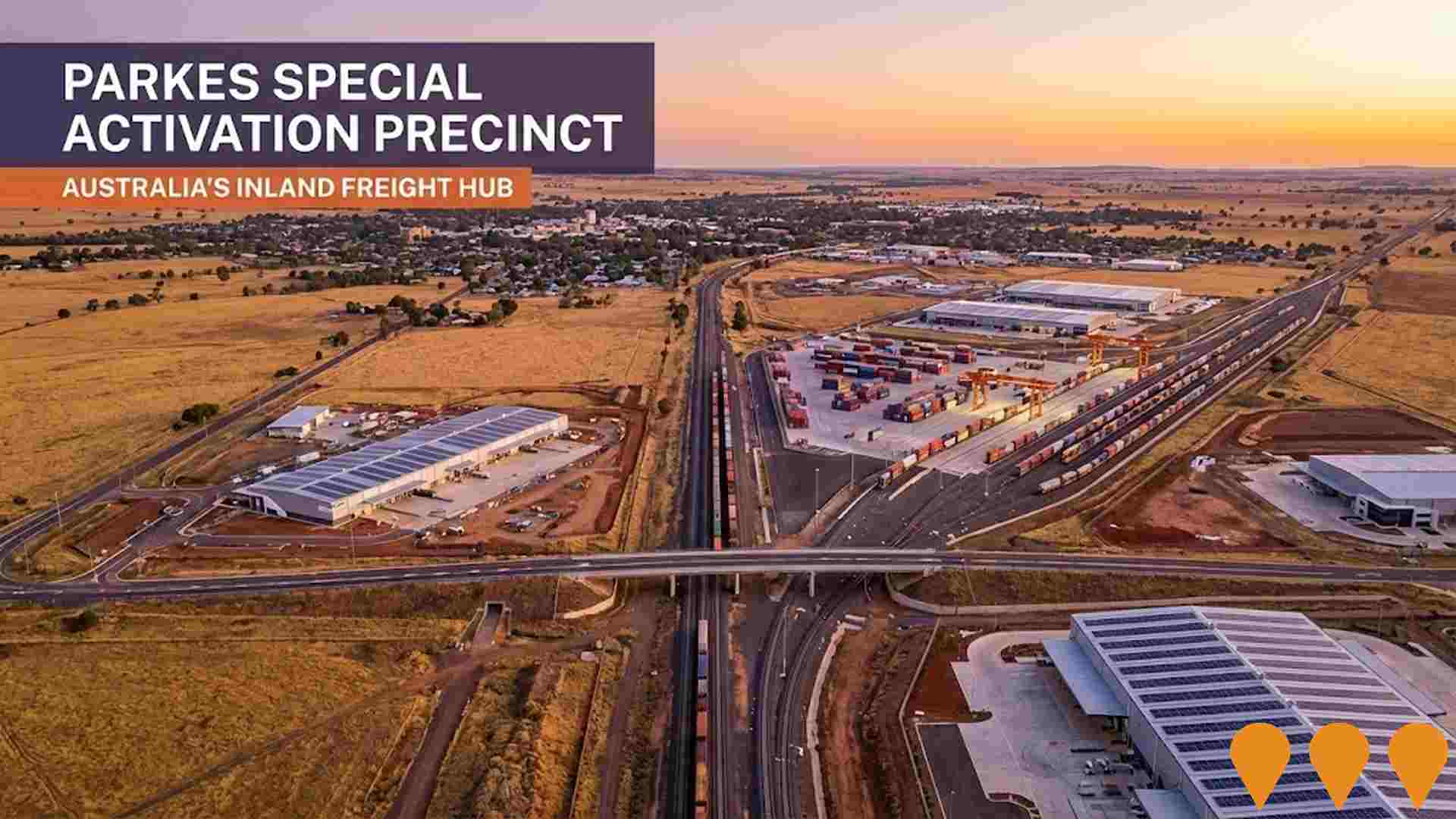
Ridgey Creek Battery Energy Storage System
Construction and operation of a 130 MW/260 MWh Battery Energy Storage System with grid-forming technology and related civil and electrical infrastructure. Features shipping containers with battery units, control equipment, inverters, transformers, and a substation connecting to the nearby Parkes Substation via underground cabling.

Pacific National Parkes Logistics Terminal
A $35 million intermodal freight terminal on 365 hectares within the National Logistics Hub. Capacity to process 450,000 containers annually with 1,800-metre rail sidings for double-stacked containers. Operational since 2019, employs 100 people. Australia's largest rail freight operator Pacific National's terminal launched operations in October 2019.
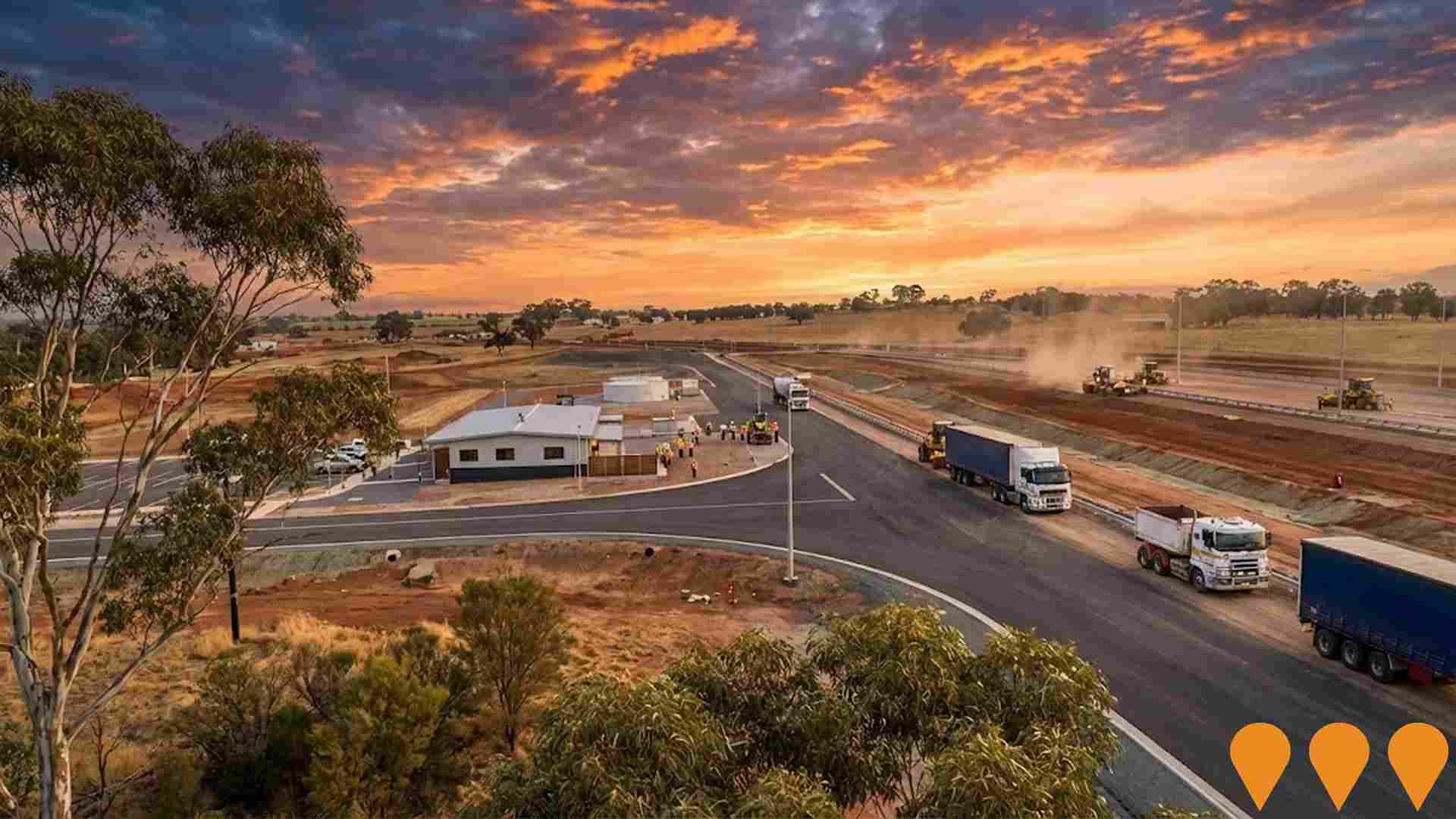
East Parkes Master Plan and Servicing Strategy
Master plan to guide development of liveable neighbourhoods with comprehensive infrastructure servicing for wastewater, water, stormwater, electricity, and natural assets. The strategy incorporates updated flood modelling from the 2022 flood event and will support up to 3,480 new dwellings in the East Parkes residential growth area. Project funded by NSW Government's Regional Housing Strategic Planning Fund and expected to be completed by mid-2026.
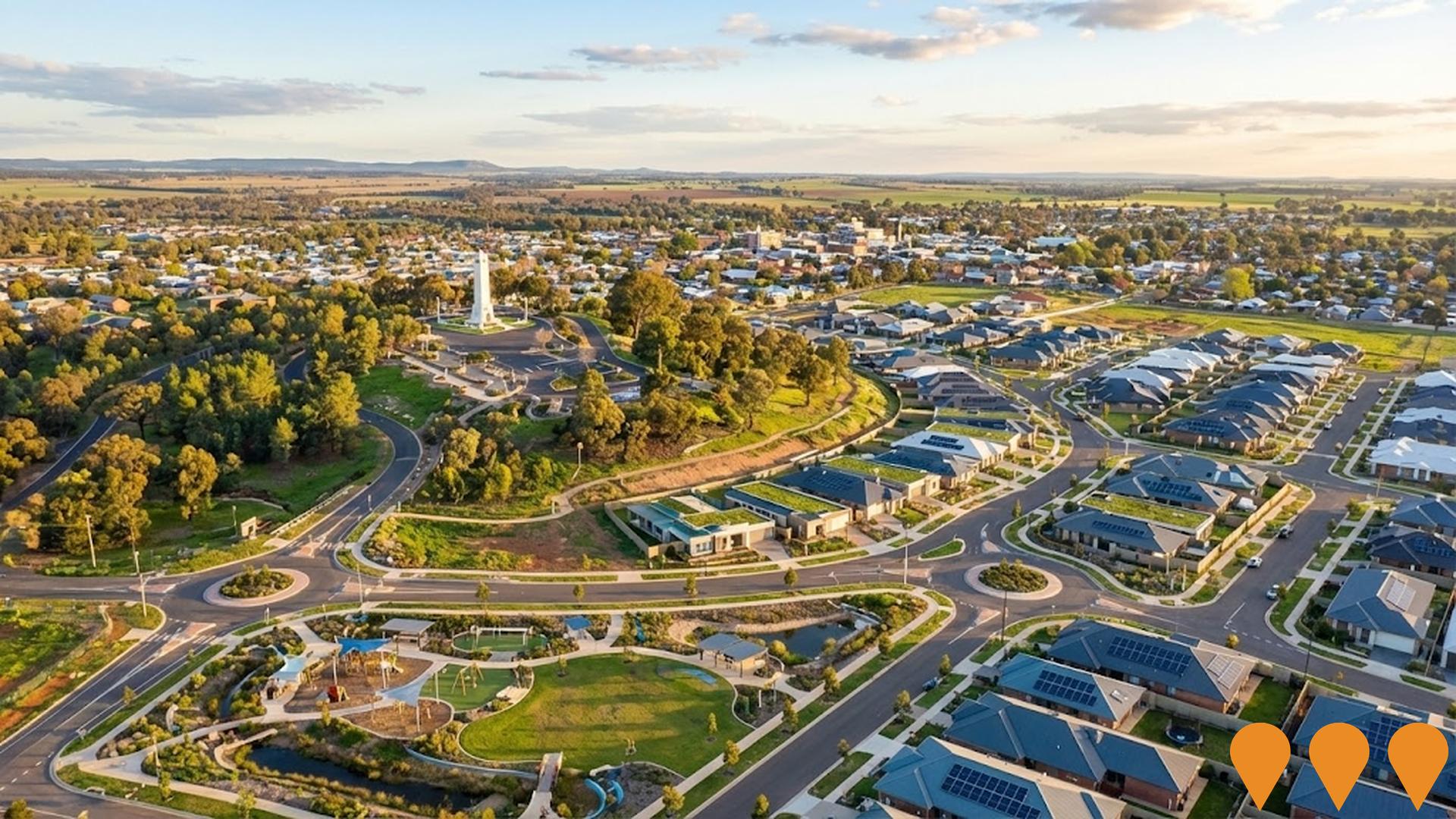
Middleton Urban Masterplan
Comprehensive urban masterplan for residential expansion in southern Parkes, supporting approximately 500 new residential lots with infrastructure for water, sewer, stormwater, transport, and open space. Includes rezoning from R5 Large Lot Residential to R1 General Residential, coordinated staging approach for sustainable growth, and integration with Parkes Hospital and existing community facilities.
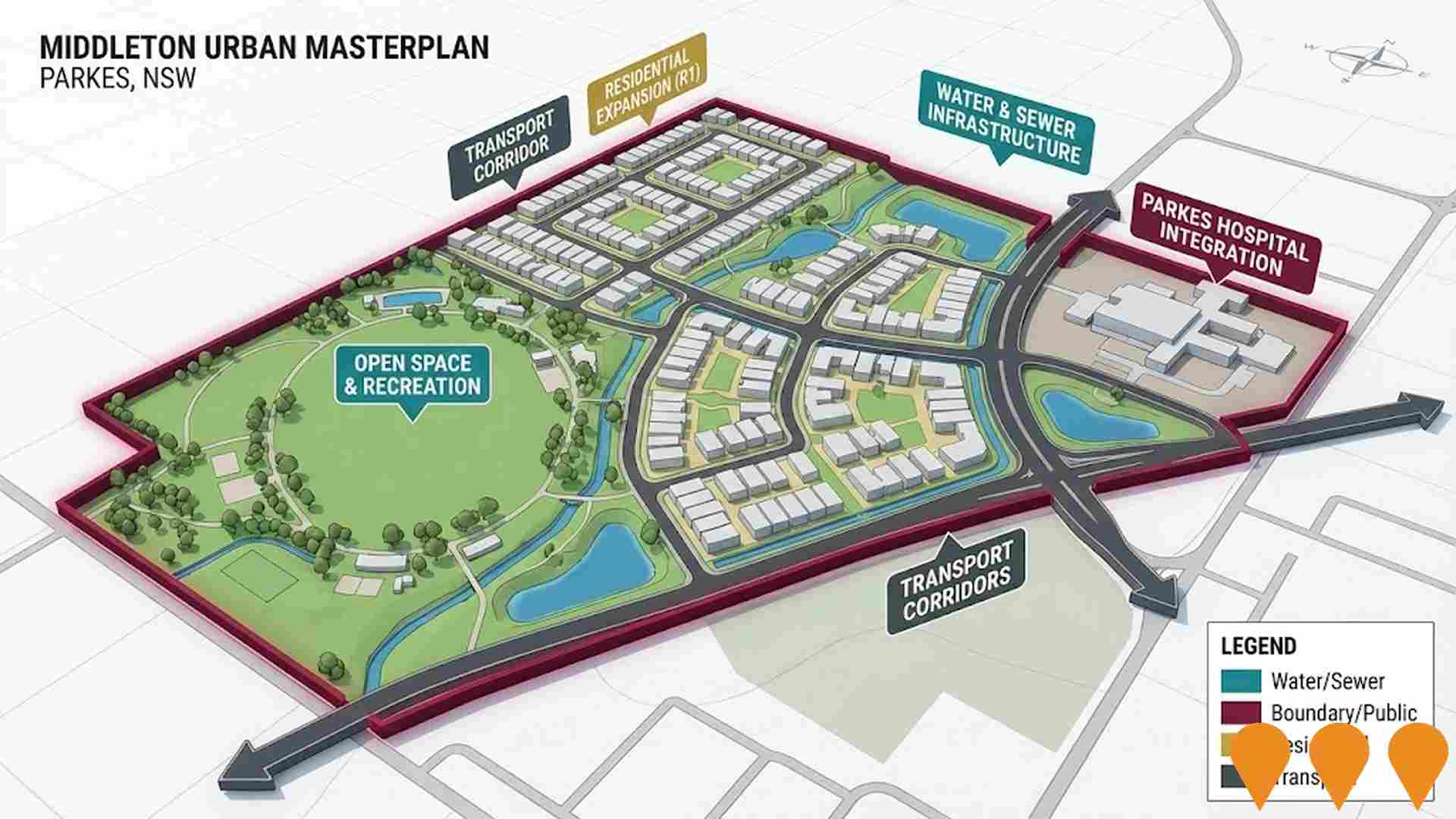
Parkes-Peak Hill Water Supply Project
A $61.7 million water infrastructure project including 39 kilometres of new pipelines, two new pump stations, upgraded Lachlan River pump station, new pre-treatment plant and raw water storage lagoon. Will more than double Parkes' current transfer capacity.
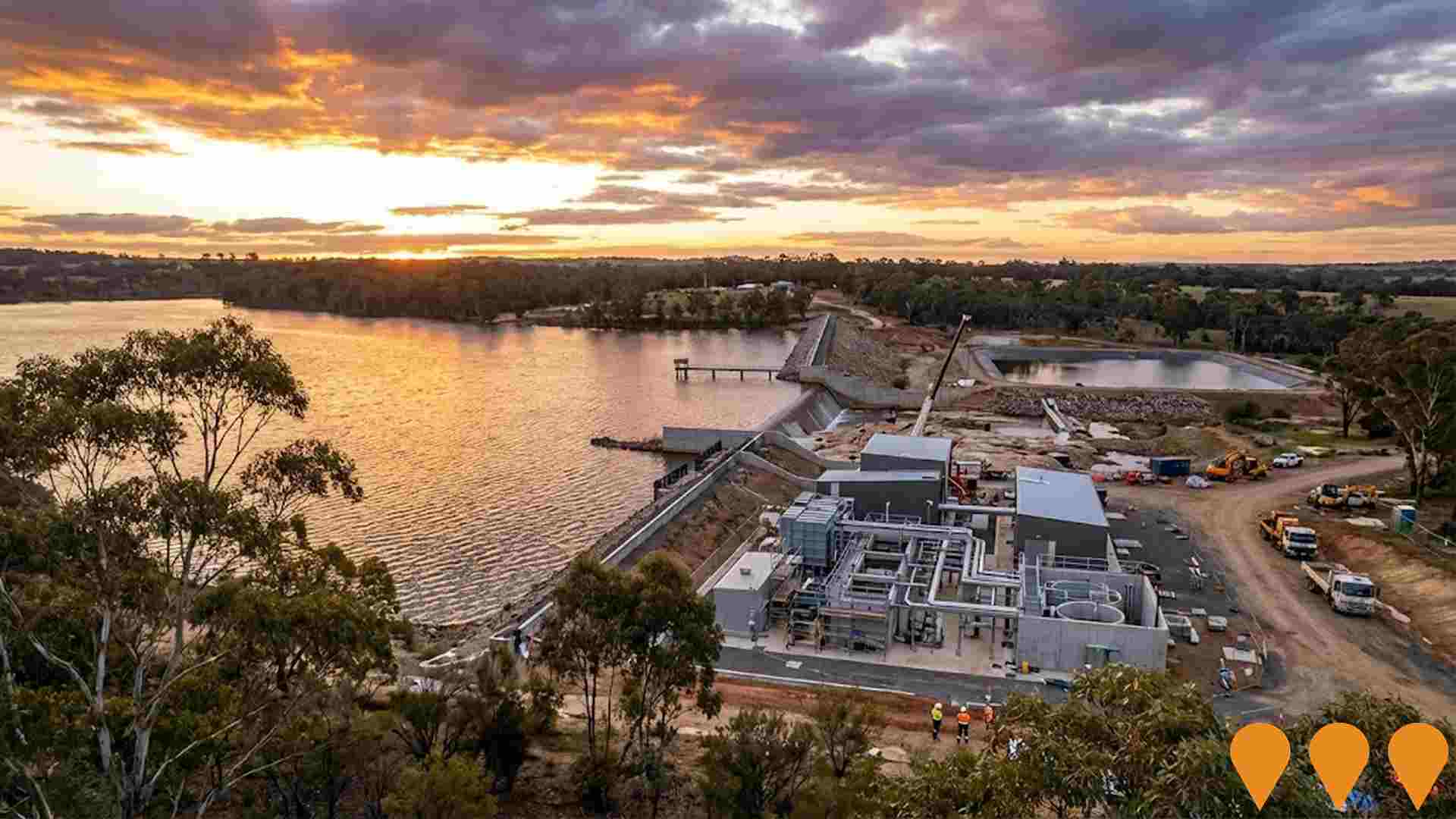
Parkes National Logistics Hub Infrastructure Extension
Infrastructure extension to deliver crucial service extensions to facilitate and enable developments in the National Logistics Hub area. Part of the broader 600-hectare logistics precinct supporting multiple anchor tenants including SCT Logistics and Linfox. Government infrastructure supporting the broader logistics ecosystem.

Employment
While Parkes Surrounds retains a healthy unemployment rate of 3.9%, recent employment declines have impacted its national performance ranking
Parkes Surrounds has a skilled workforce with diverse sector representation, an unemployment rate of 3.9% as of June 2025. It has 1,560 residents in work, with an unemployment rate of 4.2% compared to Rest of NSW's 3.7%.
Workforce participation is similar to Rest of NSW at 56.4%. Employment is concentrated in agriculture, forestry & fishing (6.6 times the regional average), health care & social assistance, and education & training. Construction is under-represented with only 3.7% of Parkes Surrounds' workforce compared to 9.7% in Rest of NSW. Many residents commute elsewhere for work based on Census data analysis.
During June 2024 to June 2025, the labour force decreased by 2.6%, employment declined by 4.1%, and unemployment rose by 1.5 percentage points, compared to Rest of NSW's changes. Jobs and Skills Australia forecasts national employment growth of 6.6% over five years and 13.7% over ten years. Applying these projections to Parkes Surrounds' employment mix suggests local growth of approximately 4.9% over five years and 11.4% over ten years, based on simple weighting extrapolation for illustrative purposes.
Frequently Asked Questions - Employment
Income
The area's income levels rank in the lower 15% nationally based on AreaSearch comparative data
Parkes Surrounds' median income among taxpayers in financial year 2022 was $41,721. The average income stood at $50,962 during the same period. These figures compare to Rest of NSW's median and average incomes of $49,459 and $62,998 respectively. Based on Wage Price Index growth of 12.61% since financial year 2022, current estimates for Parkes Surrounds would be approximately $46,982 (median) and $57,388 (average) as of September 2025. According to the 2021 Census, household, family, and personal incomes in Parkes Surrounds all fall between the 14th and 15th percentiles nationally. In income distribution, the $1,500 - $2,999 bracket dominates with 27.3% of residents (847 people), similar to the metropolitan region where this cohort represents 29.9%. Housing costs are modest, with 91.1% of income retained, but total disposable income ranks at just the 21st percentile nationally.
Frequently Asked Questions - Income
Housing
Parkes Surrounds is characterized by a predominantly suburban housing profile, with above-average rates of outright home ownership
Parkes Surrounds' dwelling structures, as per the latest Census evaluation, consisted of 95.5% houses and 4.5% other dwellings (semi-detached, apartments, 'other' dwellings), compared to Non-Metro NSW's 92.0% houses and 8.0% other dwellings. Home ownership in Parkes Surrounds was at 50.7%, with mortgaged dwellings at 26.9% and rented ones at 22.4%. The median monthly mortgage repayment was $1,083, lower than Non-Metro NSW's average of $1,200. Median weekly rent in Parkes Surrounds was $180, compared to Non-Metro NSW's $220. Nationally, mortgage repayments in Parkes Surrounds were significantly lower at $1,083 than the Australian average of $1,863, and rents were substantially below the national figure of $375.
Frequently Asked Questions - Housing
Household Composition
Parkes Surrounds features high concentrations of lone person households, with a higher-than-average median household size
Family households comprise 66.8% of all households, including 25.2% couples with children, 28.6% couples without children, and 12.2% single parent families. Non-family households account for the remaining 33.2%, with lone person households at 31.0% and group households comprising 2.3%. The median household size is 2.4 people, larger than the Rest of NSW average of 2.3.
Frequently Asked Questions - Households
Local Schools & Education
Parkes Surrounds faces educational challenges, with performance metrics placing it in the bottom quartile of areas assessed nationally
The area faces educational challenges, with university qualification rates at 16.1%, significantly lower than the NSW average of 32.2%. This presents both a challenge and an opportunity for targeted educational initiatives. Bachelor degrees are the most prevalent at 12.6%, followed by postgraduate qualifications (2.6%) and graduate diplomas (0.9%). Vocational credentials are common, with 39.8% of residents aged 15+ holding such qualifications - advanced diplomas at 8.0% and certificates at 31.8%.
Educational participation is high, with 30.6% of residents currently enrolled in formal education. This includes primary education (13.1%), secondary education (9.4%), and tertiary education (2.1%). Parkes Surrounds has 5 schools with a combined enrollment of 300 students. The area's educational conditions vary, with 3 primary and 2 K-12 schools. School places per 100 residents stand at 9.7, below the regional average of 16.0, indicating some students may attend schools in adjacent areas.
Frequently Asked Questions - Education
Schools Detail
Nearby Services & Amenities
Transport
Transport servicing is moderate compared to other areas nationally based on assessment of service frequency, route connectivity and accessibility
Parkes Surrounds has 309 active public transport stops, serving a mix of train and bus services. These stops are covered by 34 different routes, offering a total of 342 weekly passenger trips. The area's transport accessibility is rated excellent, with residents usually located 190 meters from the nearest stop.
On average, there are 48 trips per day across all routes, equating to roughly one weekly trip per individual stop.
Frequently Asked Questions - Transport
Transport Stops Detail
Health
Health performance in Parkes Surrounds is well below average with prevalence of common health conditions notable across both younger and older age cohorts
Parkes Surrounds faces significant health challenges, with common conditions prevalent among both younger and older age groups. Only approximately 46% (~1,441 people) have private health cover, compared to the national average of 55.3%.
The most frequent medical conditions are arthritis (11.0%) and asthma (9.3%). About 63.4% report no medical ailments, slightly higher than the Rest of NSW's 62.4%. Around 22.9% (~711 people) are aged 65 and over. Health outcomes among seniors show some challenges but perform better than the general population in certain health metrics.
Frequently Asked Questions - Health
Cultural Diversity
The latest Census data sees Parkes Surrounds placing among the least culturally diverse areas in the country when compared across a range of language and cultural background related metrics
Parkes Surrounds had a cultural diversity index below the average, with 88.7% of its population being Australian citizens, 95.1% born in Australia, and 97.8% speaking English only at home. Christianity was the predominant religion, accounting for 72.2% of people in Parkes Surrounds, compared to 70.4% across Rest of NSW. The top three ancestry groups were Australian (34.2%), English (30.2%), and Australian Aboriginal (10.8%).
Notably, German ancestry was overrepresented at 3.6%, compared to the regional average of 3.0%. Lebanese ancestry was also slightly higher at 0.2% versus 0.1% regionally, while Irish ancestry was lower at 7.8%, compared to 8.9% in the broader region.
Frequently Asked Questions - Diversity
Age
Parkes Surrounds hosts an older demographic, ranking in the top quartile nationwide
Parkes Surrounds' median age of 44 years is similar to Rest of NSW's 43 and above the national average of 38. Compared to Rest of NSW, Parkes Surrounds has a higher percentage of residents aged 5-14 (14.6%) but fewer residents aged 25-34 (7.6%). Between the 2021 Census and now, the 35-44 age group has increased from 10.1% to 12.3%, while the 75-84 cohort has grown from 6.4% to 7.9%. Conversely, the 25-34 age group has decreased from 9.4% to 7.6%, and the 65-74 group has dropped from 13.4% to 11.9%. By 2041, Parkes Surrounds is expected to see significant shifts in its age composition, with the 75-84 group growing by 29% (70 people), reaching 315 from 244. Meanwhile, the 65-74 and 55-64 cohorts are projected to experience population declines.

